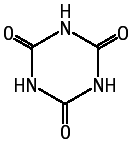

Isocyanuric acid was studied for oral toxicity in rats in an OECD combined repeat dose and reproductive/developmental toxicity screening test at doses of 0, 10, 40, 150 and 600 mg/kg/day.
With regard to repeat dose toxicity, a dose of 600 mg/kg of the test substance exerted toxic effects in male and female rats. In males, excretion of reddish urine and depression of body weight gain were noted. Urinalysis revealed crystals considered to be the test substance precipitated from the urine and increases in erythrocytes and leukocytes.
Hematological examination revealed decreased of erythrocyte counts, hemoglobin concentration and hematocrit values. Blood chemical examination revealed increases of urea nitrogen and creatinine, and a decrease of sodium. Histopathological examination revealed dilatation of the renal tubules, necrosis or hyperplasia of the tubular epithelium, increased basophilic tubules,neutrophilic infiltration, mineralization and fibrosis in the kidney, hyperplasia of the mucosal epithelium in the urinary bladder, and vacuolization of the zona fasciculata in the adrenals. Absolute and relative kidney weights and relative adrenal weights were increased. In females, excretion of reddish urine and the similar pathological changes in the kidney, urinary bladder and adrenal to those in males were observed. The incidence of atrophic thymus also showed a tendency for increase. The NOELs for repeat dose toxicity are considered to be 150 mg/kg/day for males and females. In terms of reproductive/developmental toxicity, the test substance showed no effects on any relevant parameters. NOELs for both reproductive performance and offspring development are considered to be 600 mg/kg/day.
Genotoxicity of isocyanuric acid was studied by chromosomal aberration test in cultured Chinese hamster lung (CHL/IU) cells.
Structural chromosomal aberrations and polyploidy were not induced up to a maximum concentration of 1.3 mg/ml (10 mM) on continuous treatment, and with short-term treatment with and without an exogenous metabolic activation system.
| Purity | : | 99.8% |
| Test species/strain | : | Rat/Crj:CD (SD) |
| Test method | : | OECD Combined Repeat Dose and Reproductive/Developmental Toxicity Screening Test |
| Route | : | Oral (gavage) |
| Doses | : | 0 (vehicle), 10, 40, 150, 600 mg/kg/day |
| Number of animals/group | : | Males, 10 Females, 10 |
| Vehicle | : | Sesame oil |
| Administration period | : | Males, 44 days Females, from 14 days before mating to day 3 of lactation |
| Terminal kill | : | Males, day 45 ; Females, day 4 of lactation |
| GLP | : | Yes |
Test results:
In females, excretion of reddish urine and the similar pathological changes in the kidney, urinary bladder and adrenal to those in males were observed. The incidence of atrophic thymus also showed a tendency for increase.
The NOELs for repeat dose toxicity are considered to be 150 mg/kg/day for males and females.
<Reproductive and developmental toxicity>
The parental animals exhibited no alteration in reproductive parameters including the copulation index, fertility index, gestation length, numbers of corpora lutea or implantations, implantation index, gestation index, delivery index, and behavior at delivery and lactation. There were no significant differences in offspring parameters including number of offspring or live offspring, the sex ratio, live birth index, viability index and body weight. No external or visceral abnormalities related to the test substance were detected in any of the offspring.
The NOELs for both reproductive performance and offspring development are considered to be both 600 mg/kg/day.
| Purity | : | 99.5% |
| Type of cell used | : | Chinese hamster lung (CHL/IU) cells |
| Test method | : | Guidelines for Screening Mutagenicity Testing of Chemicals (Japan) and OECD Guideline No. 473 |
| Solvent | : | Dimethylsulfoxide |
| Positive controls | : | -S9 mix, Mitomycin C +S9 mix, Cyclophosphamide |
| Doses | : | -S9 mix (continuous treatment):0, 0.33, 0.65, 1.3 mg/ml
-S9 mix (short-term treatment):0, 0.33, 0.65, 1.3 mg/ml +S9 mix (short-term treatment):0, 0.33, 0.65, 1.3 mg/ml |
| S-9 | : | Rat liver, induced with phenobarbital and 5,6-benzoflavone |
| Plates/test | : | 2 |
| GLP | : | Yes |
Test results:
| clastogenicity | polyploidy | |||||
| + | ? | - | + | ? | - | |
| Without metabolic activation: | [ ] | [ ] | [*] | [ ] | [ ] | [*] |
| With metabolic activation: | [ ] | [ ] | [*] | [ ] | [ ] | [*] |
| 1) | The tests were performed by the Research Institute for Animal Science in Biochemistry and Toxicology, 3-7-11 Hashimotodai, Sagamihara-shi, Kanagawa 229, Japan. Tel +81-427-62-2775 Fax +81-427-62-7979 |
| 2) | The tests were performed by the Hatano Research Institute, Food and Drug Safety Center, 729-5 Ochiai, Hadano-shi, Kanagawa, 257, Japan. Tel +81-463-82-4751 Fax +81-463-82-9627 |